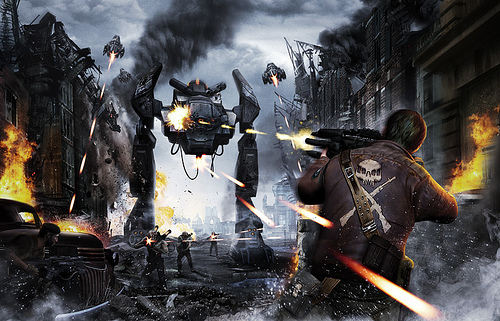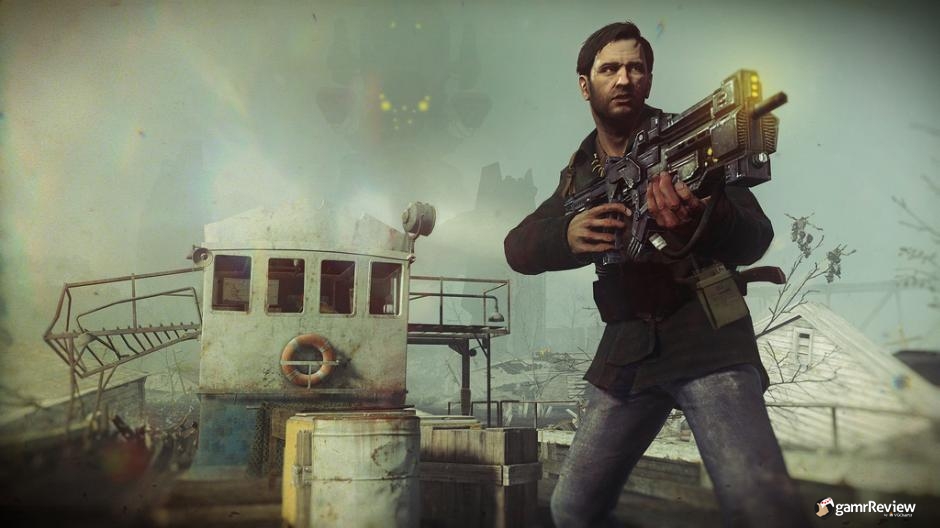When the Playstation 3 first launched in 2006, the same string of spec articles and hardware matchups marched onto the web in classic form. Aside from buzz words like ‘cores’, ‘blu-ray’ and ‘HDMI’, the subject of launch titles ultimately took center stage. With a new plateau of graphical prowess at their control, it was obvious Sony needed a game that could both push systems (not that that was going to be an issue anyway) and become a staple of a consumer’s entertainment diet. Resistance: Fall of Man was the first PS3 title to surpass 1 million units, garnered universally positive acclaim and warranted additional attention.
To the surprise of many, however, this attention would not come without repercussions. While the Resistance games are directly linked in a narrative sense, the games themselves are distinct from one another in nearly every mechanical aspect, and it has been rarely for the better. Lacking the fresh innovation from the first, the tightly-honed pacing of the second, and the emotional appeal from either predecessor, Resistance 3 is an attractive yet faulty entry carrying little impact or appeal for the single-player campaign and a cookie-cutter multiplayer that borrows heavily from other FPS games.
Upon reflection of the entire Resistance legacy, I noticed that one of its foremost problems was Insomniac’s inability to settle into a rhythm. When initiating a sequel, it’s common philosophy to leave working qualities alone and revamp/replace the aspects that didn’t mesh well. Between each entry, the changes are sometimes so vast that the effect ripples into every other design aspect of the game, forcing tweaks in every category. When replacing the weapon wheel system from the first game in favor of the two-weapon switch most known in the Halo series for the second, the intended effect of increased pacing and anticipated intensity was achieved. Consequently, enemy encounters, automatic save points, the regenerative health capabilities–almost everything needed to be changed to accommodate this variation, thus creating a very different feel that many players were not amused with. The opportunity to select a weapon best fitting the encounter was sacrificed as well, basically forcing players to accept whatever weapon had the most ammunition. Resistance 3 sees the return of the weapon wheel coupled with a an experience system, allowing the player to upgrade their preferred guns. This is one of the few details R3 has over its predecessors and is a welcome addition, though the upgrades are relatively minor improvements. Most revolve around increasing the damage output, with a few of the higher upgrades allow for bodies to become walking explosives, or bullets to travel through light cover.
The visuals remain quality work for the developers at Insomniac. Although R3 sports the blandest of environments and eye-popping backgrounds, the frame rate and visual detail is top notch. No amount of action, no matter how atmospheric or biologically gruesome, the game looks sharp and responsive. Unfortunately, the positives just about come to a halt there. R3 carries a significant amount of bugs that can potentially halt gameplay entirely and force a restart. Clipping issues remain a constant foe as enemies can appear and disappear at any given time. At one point, I was instructed to protect someone as they repaired an elevator to progress through the mine. After clearing the room, I waited while the NPC seemed to just stare at the broken engine. Though the checkpoint I restarted at was only moments away, it’s quite frustrating when the player must replay an event because of a programming error and not a personal one.
But perhaps the largest folly is in the narrative itself which is without punch, fervor or appeal. Our protagonist, Joe Capelli, reminds me of many similar gruff detectives from any cop drama as he exhibits little personality to connect to. Since helping Hale to an untimely grave at the end of R2, Capelli lives in an underground shelter with his wife and child, simply trying to keep them alive. Shortly after Malikov arrives—a veteren scientist in the Resistance storyline—so too do the Chimera and Capelli is forced to leave his family and escort Malikov to New York City. Capelli hardly interacts with his wife or son which lends to the difficulty of crafting emotional appeal for their survival or Joe’s ultimate goal. What little dialogue that is shared between them is fairly hackneyed and unbelievable, turning what should be a tearful goodbye into a sigh-inducing waste of time.
 |
| Single tear? No? |
It is of interesting note, however, that many of the journals and excerpts that can be found throughout the levels are actually more meaningful than Capelli or the various people he meets along the way. These journals include everything from notices and Chimera infection procedures to final letters of goodbye to friends and family. There is one particular journal depicting a letter written in crayon to Santa Claus, asking for the war to stop. In that moment, I felt my heartstrings strain more than the rest of the game put together. Other journals are also rife with emotion and chronicle several people’s last stand as they fight off desperation yet recognize the inevitable. Perhaps these peripheral aspects of the game were under the direction of a different department at Insomniac, but the disparity of quality between the minutia and the grand story is enough to suspect they were not written by the same people.
Another significant change was the revamped multiplayer portion. Unlike its competitors at the time, R2 made teamwork a much bigger aspect of playing online as players could select one of three different classes to help their teammates survive. It was unique enough to provide a fresh spin on multiplayer, yet still familiar enough for players to know what their role was against the enemy. Unfortunately, R3 discards all of this for a generic, not-my-first-rodeo system that borrows just about every detail from other FPS success stories. Kill streak bonuses occur at three, six, and nine kills and cannot be customized at all; higher levels lead to more active and passive abilities to choose from, though the majority are all very similar to the perks granted in the Modern Warfare games; even the modes that are supposed to be unique to the Resistance franchise bear heavy resemblance to modes from other games like Halo, M.A.G. or Battlefield.
Ultimately, Resistance 3 is a title hindered by failed potential: The potential to have a great plot in a unique universe fleshed out by two previous entries; the potential to craft compelling characters struggling with what last shreds of humanity are left on the planet; and the potential to master the qualities done well by its older brethren and become a happy marriage of finely-tuned pacing with personal combat customization and intensity. Sadly, each of these fall short of the high expectations set before them, leaving Resistance 3 as the weakest entry in the series. Whether Insomniac chooses to continue with the series or pass it along to another studio, another sequel will not be without challenge and skepticism.
See you in the next level,
Gray




No comments:
Post a Comment
LEAVE A COMMENT